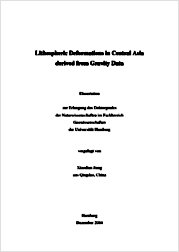Lithospheric deformations in Central Asia, derived from gravity data
Jiang, Xiaodian
Univ. Hamburg
Monografie
Verlagsversion
Englisch
Jiang, Xiaodian, 2004: Lithospheric deformations in Central Asia, derived from gravity data. Univ. Hamburg, 136 Bl. S., DOI: 10.23689/fidgeo-368.
 |
Dokument öffnen: |
Central Asia is characterized by a number of spectacular tectonic units such as the Tibetan Plateau, the Tien Shan intra-continental mountain belt and the Altyn Tagh strike-slip fault. Deformation of the lithosphere of these units is not well understood. In this dissertation, an attempt is made to answer the following tectonic questions: To what extent do the tectonic units formed in the upper crust in the course of the convergence between India and Eurasia weaken the underlying lithosphere? How is the Tibetan Plateau gravita-tionally compensated along its northern boundary? Do the Altyn Tagh and/or West Kunlun faults persist as vertical strike-slips throughout the crust and mantle lithosphere, thus representing a fundamental plate boundary? Which dynamic processes in the crust and mantle of the Tien Shan are responsible for intra-continental mountain building? What characterizes the local stress field in the Tien Shan and what causes the deformation of these mountains? To answer these questions, the elastic plate theory is used to interpret gravity and topography data, and in turn to derive specific characteristics of the lithospheric structure in Central Asia. Theoretical deflection of the elastic plate or plates were calculated using the 3D and 2D finite-difference methods. Variable-rigidity elastic plates are subjected to vertical and horizontal loads, shear forces, and terminal bending moments. Surface topo-graphic data from the Topo30 dataset is used as vertical surface loading to calculate the flexure of the elastic lithosphere...
Statistik:
ZugriffsstatistikSammlung:
- Geophysik, Extraterrestische Forschung [1223]
- Geologie [933]

